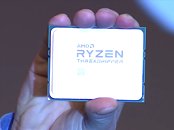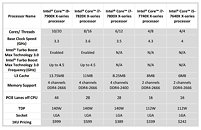Tuesday, June 6th 2017

AMD's Entry-Level 16-core, 32-thread Threadripper to Reportedly Cost $849
AMD has recently announced that at least nine models are in preparation for their new HEDT line-up, which will, for now, feature processors with up to 16 cores and 32 threads. The entry-level 16-core chip, the Threadripper 1998, will come in at 3.20 GHz with 3.60 GHz boost, 155 W TDP, and is absent of XFR.
If recent reports hold true, this entry-level Threadripper 1998 will come in at $849. Now, let's be honest - this seems like an immensely optimistic value, undercutting even Intel's 10-core 7900X, which has been announced at $999 (in tray quantities.) That's over 6 more cores and 12 more threads for $150 less. And let's just say that AMD's IPC isn't that much lower than Intel's to justify such an aggressive undercutting, a high-volume approach to the market.
Source:
ETeknix
If recent reports hold true, this entry-level Threadripper 1998 will come in at $849. Now, let's be honest - this seems like an immensely optimistic value, undercutting even Intel's 10-core 7900X, which has been announced at $999 (in tray quantities.) That's over 6 more cores and 12 more threads for $150 less. And let's just say that AMD's IPC isn't that much lower than Intel's to justify such an aggressive undercutting, a high-volume approach to the market.



128 Comments on AMD's Entry-Level 16-core, 32-thread Threadripper to Reportedly Cost $849
Also, cooling on air seems out for intel, which is no small thing for consumers/hedt.
You are aware of what IPC is, right?
Edit: lol, aircooling isnt out for intel...o_O. And since its hedt, you'd think people can afford an aio anyway...
What about unallocated costs? Are they included in this figure?
Also... $60 is a lot....Are you saying that Ryzen 7 is crippled?
$60 on a $300 part is 400% markup, i bet you wish you had a product with that kind of markup. The markup is even better on 1700x ($349) and 1800x ($449).
In VLSI fabrication you ALWAYS build the ultimate CPU and the stuff that fails test with JTAG is lasered out. Some of the Ryzen 5 cores probably have 8 working cores but if the customer pays only enough for 4 cores, they disable the other 4 cores. I think it's pretty clear (because there are so few SKUs and just about every chip overclocks at maximum GHz) that AMD took the time to optimize yields and process margin before releasing Ryzen. While $60 to make a $300 part is not as profitable as i486 (which was $25 on a $400 part - more profitable than printing money!), it is still a great profit margin. Ryzen chips are 22% smaller than equivalent Intel chips (part of this probably the lack of integrated graphics).
I don't know why AMD motherboards only have 24 PCI lanes it could be a limitation of AM4 - not the chips themselves.
Regarding "cost of manufacturing" - basically the only thing you can scale with number of cores is the cost of waffle and that's just a few % of the 60/120 USD you talk about.First of all: why do you even use markup? It's a measure used by people with 1-man businesses (e.g. house painting) that can't calculate costs effectively.
The values you suggest are nothing special, anyway.
I work in insurance. Every day I see products with infinite markups...WOW, that was obvious. But I see you have a big fondness for technical abbreviations.Markup is not profit margin.So Ryzen 7 is crippled not internally but by socket design? This is your theory? :-)
Honestly, you'll give a source for that $120 or not? Maybe you missed a zero and it's actually $1200? :-)
Someone posted information about rumored Threadripper manufacturing cost. I'd simply like to see the source.
Having multiple different cpu designs costs a lot more money.
AMD have gone for the Jack of all trades type cpu design and it works pretty good.
systemBuilder: If you can't provide a source that's fine, but don't resort to baiting.2 core boost confirmed on R7 :)
...but if being in the insurance industry gives @notb a unique perspective on computer hardware, just image what being a software engineer adds to my perspective. :kookoo:
You could simply say that you don't get irony.
SKylake X is also doing the same thing (full boost 3.0 to 2 cores instead of one).
I am definitely not 100% on this though I've been following all of this pretty closely but it's sometimes hard to remember what I've read in a forum or on an actual article.
"However at high core counts intel's monolithic die design concentrates all the thermal energy in one area which leads to an exponential build up, they have to clock the cores much lower to maintain stability, the spaced out design with cores being connected by the infinity fabric avoids this issue and allows AMD to clock Threadripper at Ryzen 1800X (or more apparently with the 12 core) and EPYC at much higher clocks than their Intel counterparts. With the sheer number of cores being used in these chips and with each chip being considerably faster due higher clocks, Xeon is going to be in for one hell of a pounding."
at worst, it seems fair to say that the gap in per core performance has become much narrower, and the amd modular fabric approach has been a big help.
the better u cool, the better it auto OCs. Simple. I like it.
It does sound a bit of a yawn now tho.
As for the "2x" idea - it's, sadly, not that simple. Production cost includes packaging, some allocated cost etc. This would make a difference.
Keep in mind Ryzen CPUs are often bundled with a cooler. :-)